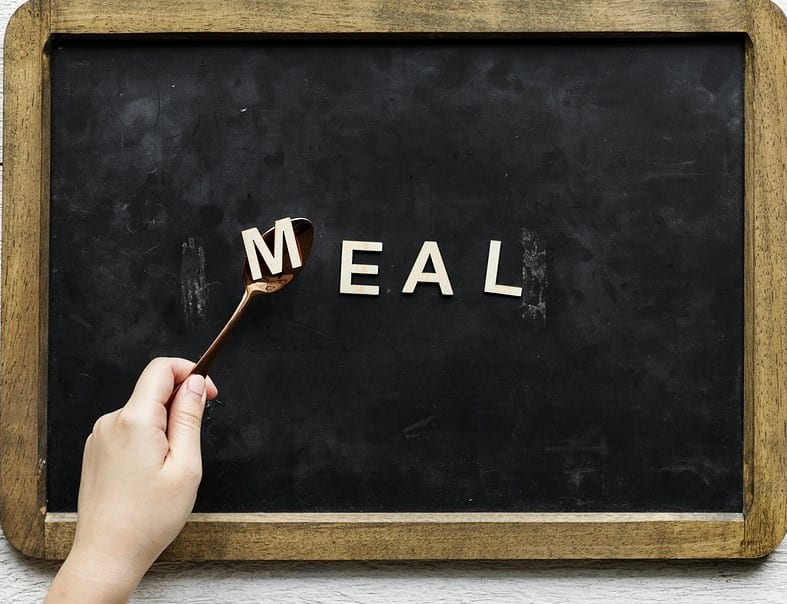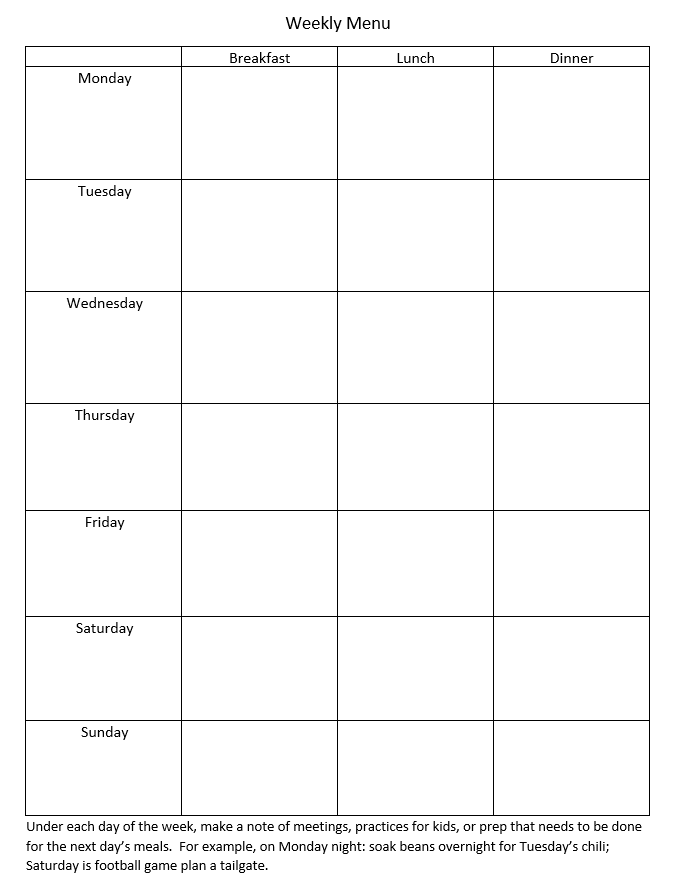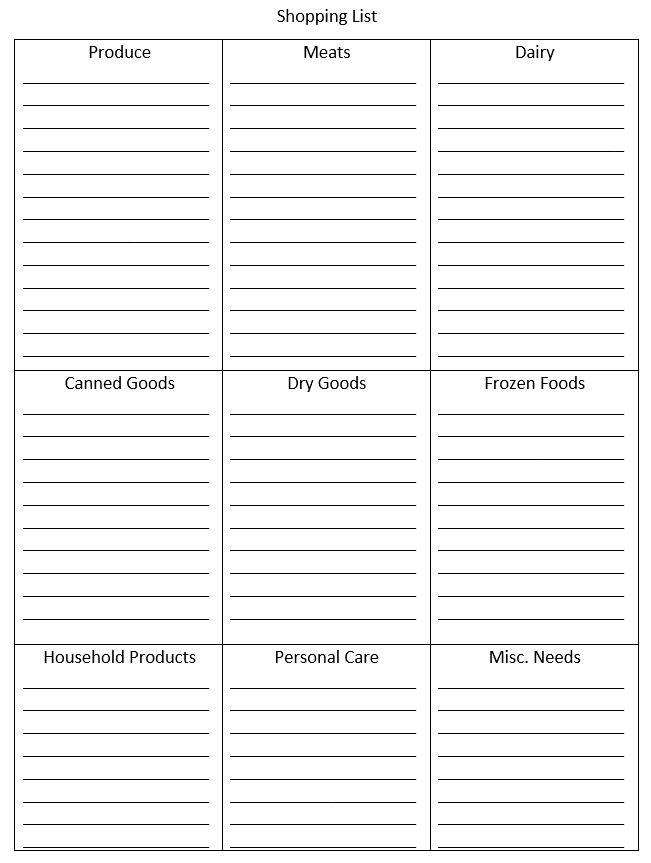
20 Simple Meal Planning Tips
and 2 Key Tools to Get You “Cooking with Gas”
The key to making healthy dietary choices and changes is planning.
It is really tempting to try to “wing it” when it comes to our meals. Unfortunately, for most people that results in a reliance on fast-food. And we all know that isn’t a healthy diet for adults or kids.
Other people avoid the fast food trap because they have a couple tried-and-true meals that they know their families will eat. Not bad, as long as they are healthy and well-balanced meals.
But r eally, even the best meals can become a bit…well…bo-ring if there isn’t enough variety. After all, you know the saying: Variety is the spice of life.
eally, even the best meals can become a bit…well…bo-ring if there isn’t enough variety. After all, you know the saying: Variety is the spice of life.
If you know your diet isn’t up to snuff and have decided it is time to make some changes, then get ready to make some plans. Like any other change in life, making changes to our diet requires some thought and effort.
Plan It to Make It
So, whether you a healthier diet or just need a little variety in your meals, let’s start with a plan!
If you didn’t grow up with a mother or father that planned the weekly menu, you may not have the skills to get started. That’s why I’ve come up with the following meal planning tips to get you going!
Tip #1: There is No One Way
The great thing about meal planning is there is no right or wrong way to plan your menu. Find the tools that work for you and use them.
If you find another tool that you find helps your family, please share it with us!
Tip #2: Follow the Seasons
Plan to eat in season. Eating seasonally is easier on your budget and allows for a varied and healthier diet.
It also supports the natural ebb and flow of the types of foods our bodies need. For example, in summer, the foods that are in season are higher in water content and that’s when we need more hydration. (Isn’t nature smart that way?)
Bonus for the eco-conscious, eating foods in season, especially if you buy locally, leaves a smaller carbon footprint. That means you AND our planet get healthier at the same time.
Tip #3: Have Theme Nights
Assign theme nights to certain days of the week. For example, you might have Saturday soup night, taco Tuesday and Friday chicken.
Don’t forget about leftovers! You can have fun with it by creating a smorgasbord with several days’ worth of leftovers for everyone to choose from!

Think having the same thing every week will be boring? A month’s worth of taco dinners might be steak tacos one week, chicken tacos another, then fish tacos, and pork (or ground beef) tacos. And be willing to think outside the box a little bit—just because it is a “taco” night doesn’t mean it has to be in a tortilla. Whether you are cutting down on carbs because of your weight loss goals or because you’re following a paleo food plan, you can substitute the tortilla or corn shell with Bibb lettuce.
With spring and summer coming up, keep your outdoor cooking and eating options available, too. Enjoy grilling your steak, chicken—even your pizza (I know that sounds strange, but I have seen it done.) Make meals fun by putting a blanket out or going to a park and having a picnic.
Tip #4: Planned-Overs
Always prepare extra when you are cooking. We call those “planned-overs”. They can be eaten at lunch the next day or repurposed for dinner the next night.
For example, I almost always have a roast chicken on Monday nights. Tuesday lunch is a salad with roast chicken. Tuesday dinner is chicken soup of some variety. We may have chicken and rice, chicken tortilla soup, or chicken pot pie.
Bonus tip: I cook my stock during the night starting on Monday after dinner. That way I have a nutrient rich bone broth to use as my base.
Tip #5: Use the Weekends
Use the weekends for planning. Plan the week’s worth of meals on the weekend. Making all the meal decisions on the weekends gives your brain a break during the hectic week.
I like to spend a little time looking at recipes in cookbooks or online. Pinterest is a great place to go and so is Food Network.
I pick a variety of meats for my main dish and then add two to three vegetables. When I plan my menu, I include every meal: breakfast, lunch, and dinner.
You can always move meals around to fit what’s going on in your life, but at a glance, you know what you need to purchase and what you have on hand to create.
Keep in mind that “weekends” don’t have to be Saturday and Sunday. If you work those days, use one of your off days for your planning time.
Tip #6: Write it Down
When you find a recipe you want to make, print it out and write down the ingredients you need to buy at the store. You’ll add the ingredient list to the “needs” list mentioned below when going to the store.
Once you’ve followed the recipe, make notes about what worked, what the family liked, what you might change next time.
I have one client who has a favorite recipe that requires a huge bowl to mix all the ingredients. She wrote on her recipe: remember to have top rack of dishwasher empty before making. That way she knows she doesn’t have to wash dishes by hand!
Tip #7: Keep it Handy
Keep a list of “Needs” posted in the kitchen. When you notice that you’re running low on a staple item, simply add it to your list. Train your family to write their needs on the list, too. They can also request meals here for you to consider for the

following week.
Having a running list of “needs” helps to prevent going to the grocery store more than a couple of days a week.
I know some people use their phones for everything. If that works for you, great! (Remember, I said there is no one “right” way.) Do keep in mind that finding a ‘home’ in the kitchen for a list makes it easy for the entire family contribute–right when they notice that you’re out of milk or oatmeal!
Tip #8: Use It or Lose It!
Always shop with a list rather than trying to rely on your memory. That’s the purpose of your “Needs” list. You know what you need to buy in order to create your meals that you so carefully planned out.
It is super frustrating to do all the shopping and then realize that you are missing one key ingredient because you either didn’t write it down or you left your list on the kitchen counter.
Using a list also helps reduce impulse buying. This helps reduce the temptation to buy foods that you don’t really need right now–or need to be eating. In other words, it saves your monetary AND dietary budgets.
Bonus tip: the perimeter of the store is generally where you will spend most of your time. In most stores, the stuff in the middle is usually the processed items and extras. Check it out—the meats, produce, and dairy sections are almost always around the edge of the store!

Tip #9: Make It Quick
Organizing the items on your list by category can make shopping quick and efficient. You’re less likely to miss something you need. Of course, you might miss out on those extra steps you would get running from one end of the store to the other and back again!
Tip #10: Plan for YOUR Family & Schedule
Don’t forget to schedule in leftovers, eating out, and special events. If you have kids that play sports, schedule a tailgate picnic and have simple finger foods.
The goal is to make it easy for everyone to easily enjoy healthy foods!
Tip #11: Hang it Up
Hang a copy of the weekly menu on your fridge or kitchen somewhere. Have any recipes that you need handy as well. That way you KNOW what you’re doing. Better yet, if you’re running late, your dear partner, or one of the kids can get dinner started.
Tip #12: Advance Prep
When you get home from shopping for your groceries, prep the vegetables as much as you can. For example, dice onions for the week, slice the zucchini, and wash the tomatoes. This make meal assembly a snap and saves time.
Tip #13: Color Outside the Lines
Eat a rainbow every day to get as wide a variety of nutrients in your diet as possible. It can also be a fun way to try something new. Have you ever had a purple carrot or yellow tomato?
Tip #14: Power Breakfast
Include vegetables in your breakfast plan. That may sound like a tall order, but it can be a simple as serving a fried egg on a tomato and topping it with some avocado slices. Or you can make it as elaborate as a vegetable frittata. If you are a smoothie family, you can put greens in the blender and no one will even notice!

Tip #15: Veg it Up
Aim to eat 8 to 12 servings of fruits and vegetables each day, mostly vegetables. The nutrients support metabolism throughout the body and boosts detoxification.
Tip #16: Quality Over Quantity
Eat high quality animal protein, wild caught fish, grass finished beef, free range chicken, or game meat.
Eat high quality fats such as real butter, coconut oil, extra virgin olive oil (for dressing salads), avocado oil, or even lard (if rendered at home to ensure its safety).
Tip #17: Keep it Real
Eat a whole foods diet, avoiding processed foods, as much as possible. This means you eat food as close as possible to how it looked while it was growing. (Of course animal protein must be processed!)
Tip #18: Know Your Limitations
If you’re following a special diet such as a low oxalate diet, low histamine diet, or a keto diet, be sure to have the list of vegetables you can eat with you as you plan for the week. Following that list, use as many vegetables as possible. Remember, the wider the variety of foods you eat, the wider of variety of nutrients you’ll get in your diet.
Tip #19: Involve the Family
Everyone in the family can help with meal planning and preparation. It might be an effort in the beginning, especially if you are making big changes to the family diet. We all want our kids to eat healthy foods and have a well-balanced diet. One of the best ways to do that is to be sure to include foods that they like.
Of  course, this can be a challenge when one person’s favorite food makes someone else gag. We can balance that out by having a variety of dishes and flavors, so there is something for everyone.
course, this can be a challenge when one person’s favorite food makes someone else gag. We can balance that out by having a variety of dishes and flavors, so there is something for everyone.
No matter how old (or young) your family members are, they can help in the meal prep, too. Think your youngster is too young to help? You might change your mind if you watch the television show Master Chef Junior!
Actually, that’s a good idea. You can watch the show as a family. Your kids can watch other kids having fun in the kitchen and making some amazing dishes. (Honestly, I don’t know how they do it!)
You might even have a Kids’ Cook Night (with varying levels of help depending on their age and skills). And if you have a partner, maybe he or she can take on the main course one night a week. If that is too much, they can make the salad or do some of the shopping.
Tip #20: Get Help
If you’re not sure what foods are best for you and your family, or if you don’t know how to cook “in season” or how to plan for special diets, or want additional meal planning tips, make an appointment with Living Well Nutrition to help you develop the best plan for your vibrant health!
Tools to Help Your Meal Planning
Here are 2 tools that I mentioned above. These are guidelines to follow, not set in stone tools you must follow. Use these, adapt them, make them your own. Remember–what works for you is what matters.
Click on this link to get a PDF version that you can download to your computer and print out: Weekly Menu
Click on this link to get a PDF version that you can download to your computer and print out: Shopping List
Which meal planning tip is your favorite?
Let us know if you use any of our tips or tools in helping to achieve your goal of a healthier diet.


